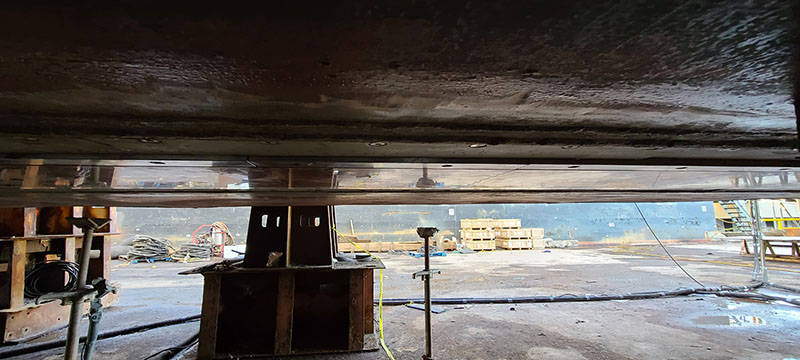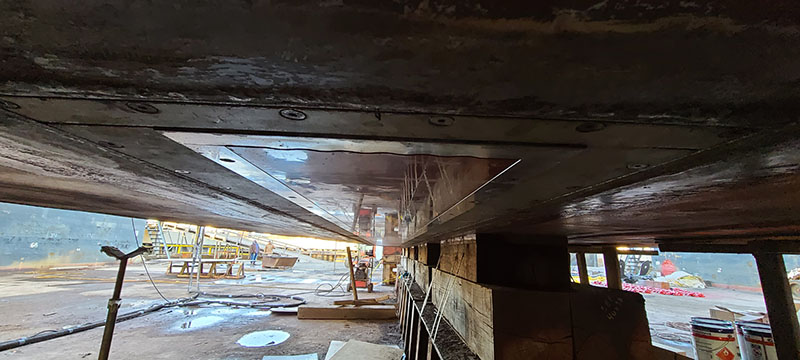
Colleen Peters, Deepwater Seafloor Mapping Expert
Published May 6, 2021
Have you upgraded your smartphone lately? Some people upgrade every time a new model comes out—but many of us wait until our current phone is broken or failing before deciding to pull the increasingly expensive trigger of technology refresh. The downside to technology is that if you wait too long to upgrade, you risk losing support—in parts or service. If you encounter a problem, it may not get solved, and then your hand is forced to make the call on a newer model whether or not your wallet is ready.
NOAA Ship Okeanos Explorer has so many different technologies onboard that the NOAA crew and staff responsible for operating the ship’s suite of scientific equipment continuously consider when is the most appropriate time to upgrade each particular system. Recently the EM302 deepwater multibeam, which has been operated nearly every day the ship has been offshore since her original commissioning in 2008 as the very first of this model in the world, was reaching the end of its life cycle when NOAA decided to move forward with an upgrade to the new model EM304 MkII rather than wait until there was an issue. As the only federal program dedicated to exploring the ocean, it is imperative for NOAA Ocean Exploration to stay at the forefront of technology, continuously paving the swath for others to follow.
Instead of swapping the multibeam system all at once, a phased replacement was planned, which was completed this past winter. The receive array was replaced in 2018. The topside transceiver unit was replaced during the winter 2019/2020 alongside repair period, and the transmit array was replaced during the winter drydock of 2020/2021.

An image of the new EM 304 transducer on the underside of NOAA Ship Okeanos Explorer, looking alongships (across the vessel, side to side). Image courtesy of Charlie Wilkins, David Blessing, and Michael Peperato; 2021 EM 304 Sea Acceptance Testing and Mapping Shakedown. Download image (jpg, 2.5 MB).

An image of the new EM 304 transducer on the underside of NOAA Ship Okeanos Explorer, looking alongships (looking in the fore-and-aft line of the vessel, in a lengthwise direction). Image courtesy of Charlie Wilkins, David Blessing, and Michael Peperato; 2021 EM 304 Sea Acceptance Testing and Mapping Shakedown. Download image (jpg, 2.4 MB).
Kongsberg Maritime designed the EM304 Mk II Deepwater multibeam to have a variety of features that are anticipated to enhance mapping efficiency as well as data quality:

Screenshot of SIS5, the multibeam data acquisition software, while the ship was underway and collecting data with the new multibeam system. Image courtesy of NOAA Ocean Exploration, 2021 EM 304 Sea Acceptance Testing and Mapping Shakedown. Download image (jpg, 885 KB).
Now comes the fun part—making sure it all works. Every installation engineer or technician works to ensure that a new system works as expected, but there are often quirks with these kinds of systems—unique to each vessel—that need to be understood by the NOAA Ocean Exploration team in order to deliver the highest quality data.
Over the years, the team has recognized that it is far more efficient to conduct thorough testing (particularly after a major upgrade) via a “shakedown” expedition like this one, prior to the start of the rest of the field season than trying to intermittently assess the performance of the system. This enables the team to efficiently plan and execute surveys, ensuring the best use of the vessel’s time, predicting accurate coverage for a given survey area, and ensuring the highest quality of data collected and shared with the community.
As this is one of the first complete EM 304 systems in operation worldwide, the testing performed during this expedition will be invaluable not only to NOAA Ocean Exploration, but also to the broader ocean mapping community.
At the time of writing this feature, the onboard team had officially accepted the new system, through successfully performing the Sea Acceptance Trials defined by Kongsberg and additional testing routines defined by the Multibeam Advisory Committee . System performance will continue to be evaluated against the manufacturer’s expectations based on system design and theory. System performance typically varies with environmental and oceanographic conditions such as sea state, seawater temperature and salinity variability, and seabed reflectivity.